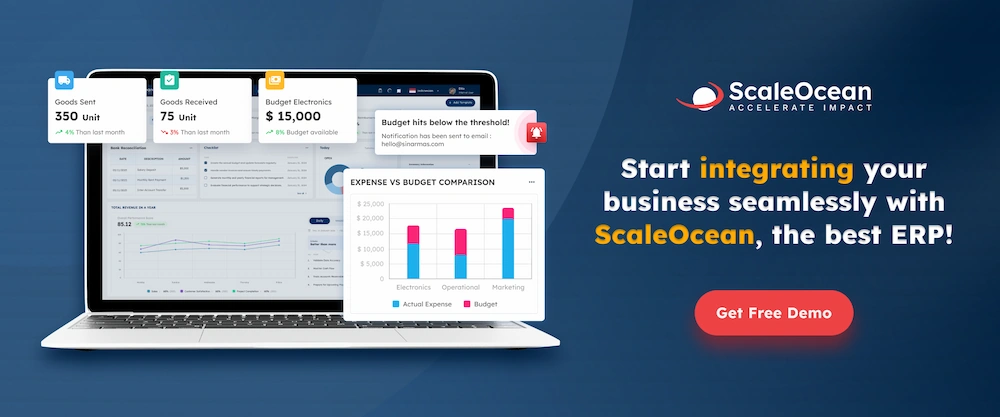ERP (Enterprise Resource Planning) implementation is critical for modern businesses looking to streamline operations and enhance efficiency, from construction, manufacturing, logistics, and many more. By integrating various business processes into a unified system, ERP can transform how organizations function. For many businesses, the move to ERP is driven by a need to improve data visibility, enhance coordination among departments, and optimize operational efficiency.
However, the characteristics of ERP systems requires a meticulous approach to implementation, which is divided into distinct phases to ensure thoroughness and effectiveness. This article explores the 4 major phases of ERP implementation, providing a comprehensive guide for businesses to ensure a successful transition.
1. Planning and Preparation
Understanding these ERP implementation phases in detail not only prepares an organization for what to expect but also equips it with the knowledge to tackle common challenges that arise during the process. This phased approach ensures that all critical aspects such as specific business needs, feature requirements, and others, are adequately covered.
a. Assessing Business Needs
The first step in ERP implementation approaches involves a thorough assessment of your business needs. This phase is crucial as it lays the foundation for the entire project. Determine your company’s precise needs and objectives first. This entails identifying inefficiencies, comprehending the current procedures, and outlining your goals for the new ERP system, including the potential benefits of mobile ERP software for on-the-go accessibility and efficiency. This evaluation aids in the selection of the best ERP solution that supports your company’s goals.
This analysis involves gathering input from stakeholders across all departments to ensure that the ERP system addresses both current issues and future growth plans. By thoroughly understanding the processes that will be impacted by the ERP implementation, companies can identify potential bottlenecks and areas requiring special attention.
b. Choosing the Right ERP Vendor
Once you have a clear understanding of your business needs, the next step is to choose an ERP system that fits those requirements. With numerous ERP solutions available, selecting the right one can be daunting. Evaluate different vendors and systems based on features, scalability, and cost. It’s also beneficial to check references and testimonials from other clients, particularly those in similar industries.
Additionally, request a demo, to find out how the system works. Consider a vendor whose capabilities align with your specific industry needs and who demonstrates a clear understanding of your business processes. Choosing the right ERP system is a critical phase in the 4 major phases of ERP implementation, ensuring that the solution you select will support your business growth.
c. Creating a Detailed Project Plan
Developing a detailed project plan is the final step in the planning and preparation phase. This plan should outline the entire ERP implementation process, including timelines, milestones, and resources required. This plan should outline the resources required at each stage, including time, budget, and personnel. By breaking down the project into manageable segments, you can monitor progress effectively and make adjustments as needed to stay on track. A well-structured project plan helps keep the project on track and ensures all stakeholders are aligned. It also allows for better management of expectations and provides a roadmap for the subsequent phases of ERP implementation.
Also Read:
What is ERP System? A Detailed Description
2. Design and Development
This ERP implementation phases is centered around tailoring the ERP system to fit the unique needs and processes of your business. Customizations are made during this phase to adapt the ERP to the specific operational, ensuring that every functionality aligns perfectly with the objectives outlined during the planning phase. By the end of this phase, the ERP system should be fully configured, integrated, and ready for rigorous testing in the subsequent phase.
a. Customizing the ERP System
Customization is a vital aspect of ERP implementation approaches. Since every company has different needs and procedures, customizing the ERP system is crucial. Configuring a custom built ERP system to meet your unique company requirements is known as customization. This can involve altering workflows, producing unique reports, and integrating with other systems. The goal is to ensure the ERP system supports your business processes seamlessly, enhancing overall efficiency and productivity. It is essential to balance customization with standard practices to avoid overcomplicating the system.
b. Data Migration & Integration
Ensuring that existing data is accurately transferred to the new ERP system is crucial for maintaining continuity of operations and ensuring data accuracy and completeness. This step involves preparing the data for migration, mapping it accurately to the new system, and conducting thorough testing to ensure integrity. Additionally, integrating the ERP system with other business applications is crucial for creating a cohesive technology ecosystem and maintaining efficient workflow. Proper data migration and integration set the stage for a smooth transition to the new system. Use data validation and testing to ensure that data integrity is maintained throughout the process.
c. Developing Workflows and Processes
The development of workflows and processes within the ERP system is essential for aligning it with your business operations. This involves designing efficient workflows that streamline tasks and improve productivity. Ensure that these workflows are intuitive and easy to follow, minimizing the learning curve for employees. Developing robust processes within the ERP system is a key step in the 4 major phases of ERP implementation, as it directly impacts the system’s effectiveness. Collaboration with end-users during this phase ensures that the workflows meet practical business needs.
3. Testing and Training
These ERP implementation phases are designed to ensure that the system functions correctly and meets all specified requirements before going live. During this stage, every aspect of the ERP system is scrutinized to uncover any issues that could impede its performance. It is important to verify that the system can handle real-world operational demands without failure. Also, ensure users understand how to make the most of its features to enhance their daily tasks.
a. System Testing
System testing is a critical phase in ERP implementation approaches. Before the full-scale deployment, it’s essential to conduct thorough testing to identify and resolve any issues. This includes unit testing, integration testing, and user acceptance testing (UAT). Each type of testing serves a specific purpose, ensuring that the ERP software functions correctly and meets business requirements. Addressing any bugs or discrepancies during testing helps prevent disruptions during the actual deployment. Testing should be iterative, with feedback loops to refine and improve the system continually.
b. User Training
Training employees is vital for successful ERP implementation approaches. Training focuses on preparing the end-users for their interactions with the new ERP system. Without proper training, users may struggle to adapt to the new system, leading to inefficiencies.
Develop a comprehensive training program that covers all aspects of the ERP system, from basic navigation to advanced features. Use various training methods, such as workshops, online tutorials, and hands-on sessions, to accommodate different learning styles. Effective training ensures that employees can leverage the ERP system to its full potential. Continuous learning opportunities post-implementation can help employees stay updated with system enhancements.
c. Pilot Implementation
The pilot implementation involves deploying the ERP system in a controlled environment, typically within a specific department or business unit. The pilot phase allows you to test the system in a real-world setting, gather feedback, and make necessary adjustments before the full-scale rollout. Addressing any issues identified during the pilot phase ensures a smoother and more successful overall implementation. This stage also helps in refining training materials and support documentation based on real user experiences.
4. Deployment and Post-Implementation
One of the 4 major phases of ERP implementation marks that the system is fully launched and integrated into the day-to-day operations of your business. It is time to monitor the system’s performance closely and address any issues that arise quickly to minimize disruptions to business operations.
a. Full-Scale Deployment
Full-scale deployment is the culmination of the ERP implementation phases. This phase involves rolling out the ERP system across the entire organization. Planning and coordination are crucial to minimize disruptions and ensure a smooth transition. Communicate the deployment plan to all stakeholders and provide additional support as needed. A successful deployment ensures that the ERP system is fully integrated into daily operations, driving efficiency and productivity. Regular monitoring during the initial period of full-scale deployment can help quickly identify and resolve any issues.
b. Continuous Support and Maintenance
Post-implementation support and maintenance are essential for the long-term success of the ERP system. Support teams play a crucial role in this phase, providing immediate assistance to resolve any technical problems and helping users adapt to the new system. This phase involves ongoing monitoring, troubleshooting, and updates to ensure the system remains efficient and effective. Establish a support team to address any issues promptly and provide continuous training to keep employees updated on new features and best practices. Continuous support helps maximize the benefits of the ERP system and ensures it adapts to evolving business needs. Scheduled maintenance and updates ensure the system remains current and secure.
c. Measuring Success and ROI
Evaluating the success of the ERP implementation involves tracking key performance indicators (KPIs) and return on investment (ROI) to assess the system’s impact on business operations. Regularly reviewing these metrics helps identify areas for improvement and ensures that the ERP software continues to deliver value. For companies applying for business grants, demonstrating clear improvements in operational efficiency through the ERP system can enhance their chances of securing funding.
Measuring success and ROI is crucial for understanding the overall effectiveness of the ERP implementation approaches and guiding future enhancements. Regular feedback from users can also provide insights into areas for further system improvement.
5. Conclusion
In conclusion, ERP implementation approaches require meticulous planning, execution, and ongoing management. Each of 4 major phases of ERP implementation plays a crucial role in ensuring the ERP system meets business requirements, ultimately leading to significant improvements in business processes and operational efficiencies.
ScaleOcean is dedicated to ensuring a smooth and successful implementation of your ERP system at every stage. From initial planning and customization to deployment and ongoing support, our expert team is committed to providing a seamless integration experience. Ready to see how our ERP system can transform your business operations? Request a demo with us today to empower your business with an ERP solution that drives efficiency and growth.




 Click to Chat!
Click to Chat!